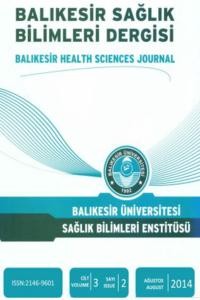Öz
Mitokondriyal nörogastrointestinal ensefalomiyopati (MNGIE) nadir görülen otozomal resesif geçişli multisistemik bir hastalıktır. Timidin fosforilaz (TMYP) gen mutasyonu ve timidin fosforilaz enzim aktivitesinde bozulmaya bağlı olarak plazmada timidin ve deoksiuridin düzeylerinde artış olmaktadır. MNGIE pitoz, progresif eksternal oftalmopleji, gastrointestinal dismotilite, kaşeksi, periferal nöropati ve lökoensefalopati gibi klinik bulgularla karakterizedir.Klinik semptomların başlangıcı genellikle birinci ve beşinci dekadlar arasında olmakla birlikte hastaların %60 ında 20 li yaşlardan önce olmaktadır. Yaşam beklentisi bu hastalarda sınırlıdır ve ölüm genellikle üçüncü ve dördüncü dekadlarda kaşeksi ve intestinal komplikasyonlardan olmaktadır. Prevelansı bilinmemektedir.İlk tanımlandığı günden bu yana MNGİE hastalığı ile uyumlu özelliklere sahip 70 den az kişi bildirilmiştir. Bu makalede birçok kez gastroenteroloji kliniğinde tetkik edilmiş ancak tanı konamamış, nadir görülen bir mitokondriyal hastalık olan MNGİE sendromu olgusu sunulmuştur.
Anahtar Kelimeler
Kaynakça
- 1. Garone C, Tadesse S, Hirano M. Clinical and genetic spectrum of mitochondrial neurogastrointestinal encephalomyopathy. Brain 2011;134(11)
- 2. Libernini L, Lupis C, Mastrangelo M. Mitochondrial Neurogastrointestinal Encephalomyopathy: novel pathogenic mutations in thymidine phosphorylase gene in two Italian brothers. Neuropediatrics 2012;43(4):201
- 3. Hirano M, Silvestri G, Blake DM., Lombes A, Minetti C, Bonilla E,et al. Mitochondrial neurogastrointestinal encephalomyopathy (MNGIE): clinical, biochemical and genetic features of an autosomal recessive mitochondrial disorder. Neurology 1994; 44(4): 721
- 4. Halter J, Schüpbach WM, Casali C, Elhasid R, Fay K, Hammans S,et al. Allogeneic hematopoietic SCT as treatment option for patients with mitochondrial neurogastrointestinal encephalomyopathy (MNGIE): a consensus conference proposal for a standardized approach. Bone Marrow Transplant 2011;46(3):330.
- 5. Moran NF, Bain MD, Muquit MM, Bax BE: Carrier erythrocyte entrapped thymidine phosphorylase therapy for MNGIE. Neurology 2008;71(9):686.
- 6. Barth ML, Fensom A. Prevalence of common mutations in the arylsulphatase A gene in metachromatic leukodystrophy patients diagnosed in Britain. Hum Genet 1993;91(1):73-77.
- 7. Tannesen T, Vrang C. Atypical metachromatic leukodystrophy? Problems with the biochemical diagnosis. Hum Genet 1984;67(2):170-3.
- 8. Rauschka H, Colsch B, Baumann N, Wevers R, Schmidbauer M, Krammer M, et al. Late-onset metachromatic leukodystrophy: genotype strongly influences phenotype. Neurology 2006;67(5):859-63.
- 9. Bosch EP, Smith BE. Disorders of Peripheral Nerves. In: Bradley WG, Daroff RB, Fenichel GM, Marsden CD (eds). Neurology in Clinical Practice. 3rd ed. Boston: Butterworth-Heinemann 2000:1661-2, 1741-2, 2076-7.
- 10. Biffi A, Capotondo A, Fasano S, del Carro U, Marchesini S, Azuma H, et al. Gene therapy of metachromatic leukodystrophy reverses neurological damage and deficits in mice. J Clin Invest 2006;116(11)
- 11. Selcuki D, Bakar E, Kömürcülü N. Nadir görülen bir geç distoni nedeni:erişkin başlangıçlı metakromatik lökodistrofi (olgu sunumu). Gülhane Tıp Dergisi 2009;51(1):45-8.
Öz
Mitochondrial Neurogastrointestinal Encephalomyopathy(MNGIE) is a rare autosomal recessive multisystemic disorder. Thymidine and deoxyuridine levels are increased due to thymidine phosphorilase enzyme dysfunction caused by mutations in a nuclear gene coding for the enzyme thymidine phosphorylase (TYMP). MNGIE is clinically characterized by ptosis, progressive external ophthalmoparesis, gastrointestinal dysmotility, cachexia, peripheral neuropathy and leukoencephalopathy. Clinically onset is usually between the first and fifth decades; in about 60% of individuals, symptoms begin before age 20 years. Life expectancy is limited and death usually occurs during the third or fourth decades generally due to cachexia and intestinal complications. The prevalence is unknown. Fewer than 70 individuals with features consistent with MNGIE disease have been reported since it was first described. In this report we represent a MNGIE syndrome case whıch is a rare seen disease that remained undiagnosed although it was examined several times in gastroenterology department.
Anahtar Kelimeler
Mitochondrial neurogastrointestinal encephalomyopathy syndrome
Kaynakça
- 1. Garone C, Tadesse S, Hirano M. Clinical and genetic spectrum of mitochondrial neurogastrointestinal encephalomyopathy. Brain 2011;134(11)
- 2. Libernini L, Lupis C, Mastrangelo M. Mitochondrial Neurogastrointestinal Encephalomyopathy: novel pathogenic mutations in thymidine phosphorylase gene in two Italian brothers. Neuropediatrics 2012;43(4):201
- 3. Hirano M, Silvestri G, Blake DM., Lombes A, Minetti C, Bonilla E,et al. Mitochondrial neurogastrointestinal encephalomyopathy (MNGIE): clinical, biochemical and genetic features of an autosomal recessive mitochondrial disorder. Neurology 1994; 44(4): 721
- 4. Halter J, Schüpbach WM, Casali C, Elhasid R, Fay K, Hammans S,et al. Allogeneic hematopoietic SCT as treatment option for patients with mitochondrial neurogastrointestinal encephalomyopathy (MNGIE): a consensus conference proposal for a standardized approach. Bone Marrow Transplant 2011;46(3):330.
- 5. Moran NF, Bain MD, Muquit MM, Bax BE: Carrier erythrocyte entrapped thymidine phosphorylase therapy for MNGIE. Neurology 2008;71(9):686.
- 6. Barth ML, Fensom A. Prevalence of common mutations in the arylsulphatase A gene in metachromatic leukodystrophy patients diagnosed in Britain. Hum Genet 1993;91(1):73-77.
- 7. Tannesen T, Vrang C. Atypical metachromatic leukodystrophy? Problems with the biochemical diagnosis. Hum Genet 1984;67(2):170-3.
- 8. Rauschka H, Colsch B, Baumann N, Wevers R, Schmidbauer M, Krammer M, et al. Late-onset metachromatic leukodystrophy: genotype strongly influences phenotype. Neurology 2006;67(5):859-63.
- 9. Bosch EP, Smith BE. Disorders of Peripheral Nerves. In: Bradley WG, Daroff RB, Fenichel GM, Marsden CD (eds). Neurology in Clinical Practice. 3rd ed. Boston: Butterworth-Heinemann 2000:1661-2, 1741-2, 2076-7.
- 10. Biffi A, Capotondo A, Fasano S, del Carro U, Marchesini S, Azuma H, et al. Gene therapy of metachromatic leukodystrophy reverses neurological damage and deficits in mice. J Clin Invest 2006;116(11)
- 11. Selcuki D, Bakar E, Kömürcülü N. Nadir görülen bir geç distoni nedeni:erişkin başlangıçlı metakromatik lökodistrofi (olgu sunumu). Gülhane Tıp Dergisi 2009;51(1):45-8.
Ayrıntılar
| Birincil Dil | Türkçe |
|---|---|
| Bölüm | Olgu sunumları |
| Yazarlar | |
| Yayımlanma Tarihi | 31 Ağustos 2014 |
| Gönderilme Tarihi | 3 Ocak 2014 |
| Yayımlandığı Sayı | Yıl 2014 Cilt: 3 Sayı: 2 |



